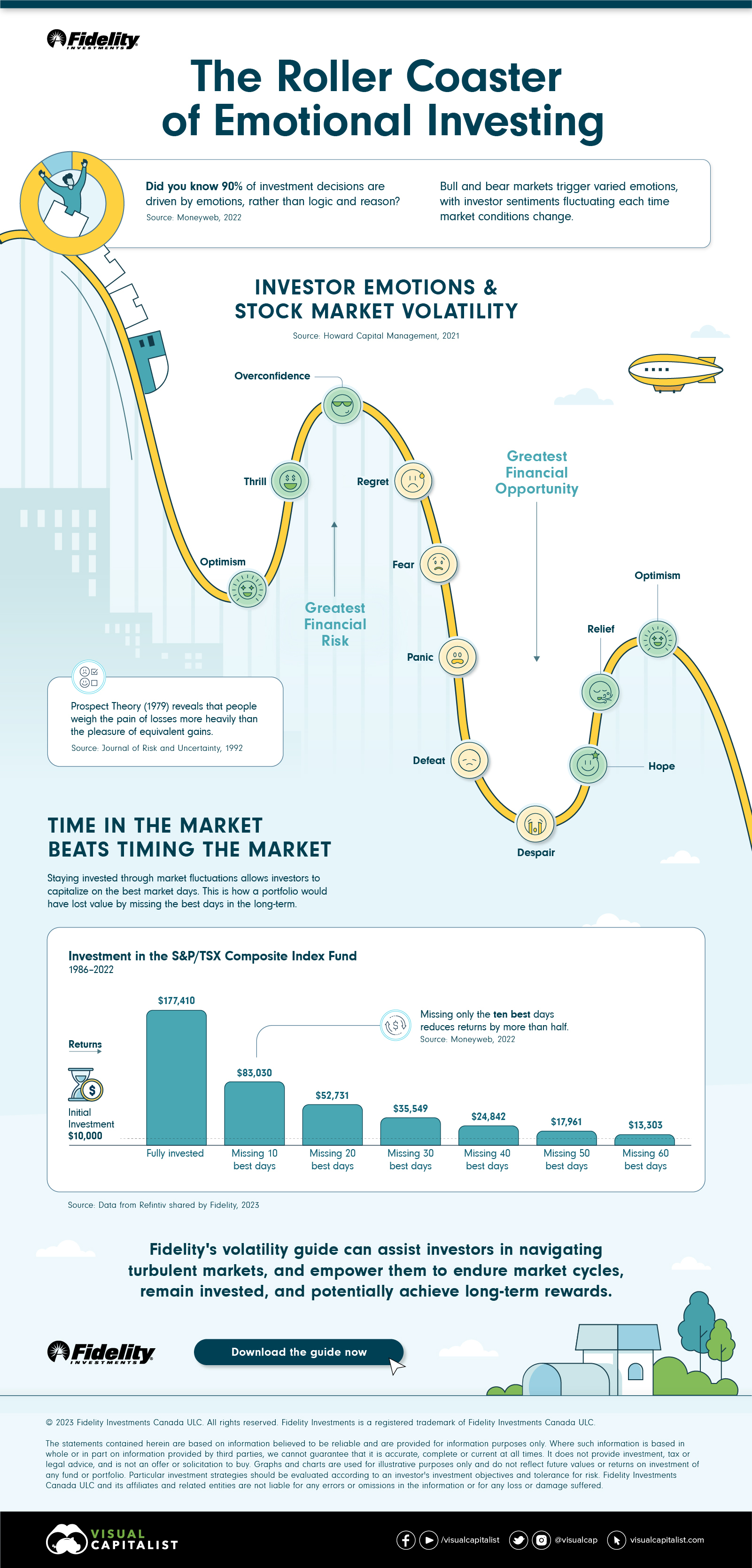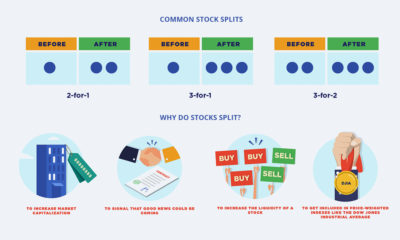
Published
36 mins ago
on
August 16, 2023
| 30 views
-->
By
Rida Khan
Graphics & Design
- Alejandra Dander
The following content is sponsored by Fidelity Investments
The Roller Coaster of Emotional Investing
Did you know that 90% of investment decisions are influenced by emotions? And this is amplified during extreme bull and bear markets, putting investors’ impulses to test.
In this infographic sponsored by Fidelity Investments, we delve into behavioral finance to uncover the highs and lows of emotional investing and understand why time in the market beats timing the market.
The Emotional Investing Journey
According to the Prospect Theory (1979), losses have a higher emotional impact than equivalent gains. This means that the emotional toll of losing $100,000 outweighs the satisfaction of gaining the same amount. This, in turn, impacts how investors adjust their strategies. For example, despite the common knowledge that when markets dip, it is a golden time for investors to enter, they respond with uncertainty, according to research by Howard Capital Management.
Then, as the market rebounds, surging investor optimism can often lead to overestimations of how high the next peak will be.
Time vs. Timing
Staying invested through market fluctuations allows investors to benefit from the best market days without having to make big buy or sell decisions.
Here, using Refinitiv’s research, we consider a $10,000 investment from 1986 to 2022 and compare its performance when consistently invested versus missing the top market days.
| Portfolio Value | Change in Value From Peak | |
|---|---|---|
| Stayed fully invested | $177,410 | - |
| Missed 10 best days | $83,030 | -$94,380 |
| Missed 20 best days | $52,731 | -$124,679 |
| Missed 30 best days | $35,549 | -$141,861 |
| Missed 40 best days | $24,842 | -$152,568 |
| Missed 50 best days | $17,961 | -$159,449 |
| Missed 60 best days | $13,303 | -$164,107 |
This shows that missing only the 10 best days reduces returns by more than half. Hence, staying invested amid market fluctuations enables investors to optimize their returns.
Fidelity’s volatility guide serves as a compass to help investors navigate turbulence and maintain a long-term perspective.

Download Fidelity’s volatility guide.

Please enable JavaScript in your browser to complete this form.Enjoying the data visualization above? *Subscribe
Related Topics: #portfolio trajectories #volatility guide #S&P index #emotional investing #Stay invested #Long term investing #volatility #Market fluctuations #portfolio #Bull and bear markets #index #best market days #profits #Prospect theory #timing the market #investor sentiments #fidelity #behavioral finance #fidelity investments
Click for Comments
var disqus_shortname = "visualcapitalist.disqus.com";
var disqus_title = "The Roller Coaster of Emotional Investing and Its Impact on Portfolios";
var disqus_url = "https://www.visualcapitalist.com/sp/roller-coaster-of-emotional-investing/";
var disqus_identifier = "visualcapitalist.disqus.com-160319";
You may also like
-

Investor Education2 months ago
Visualizing BlackRock’s Top Equity Holdings
BlackRock is the world’s largest asset manager, with over $9 trillion in holdings. Here are the company’s top equity holdings.
-

Markets2 months ago
10-Year Annualized Forecasts for Major Asset Classes
This infographic visualizes 10-year annualized forecasts for both equities and fixed income using data from Vanguard.
-

Investor Education5 months ago
Visualizing 90 Years of Stock and Bond Portfolio Performance
How have investment returns for different portfolio allocations of stocks and bonds compared over the last 90 years?
-

Debt1 year ago
Countries with the Highest Default Risk in 2022
In this infographic, we examine new data that ranks the top 25 countries by their default risk.
-

Investor Education1 year ago
The Best Months for Stock Market Gains
This infographic analyzes over 30 years of stock market performance to identify the best and worst months for gains.
-

Markets2 years ago
A Visual Guide to Stock Splits
If companies want their stock price to rise, why would they want to split it, effectively lowering the price? This infographic explains why.
Subscribe
Please enable JavaScript in your browser to complete this form.Join the 375,000+ subscribers who receive our daily email *Sign Up
The post The Roller Coaster of Emotional Investing and Its Impact on Portfolios appeared first on Visual Capitalist.